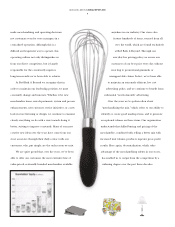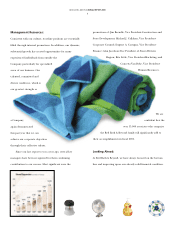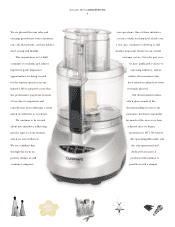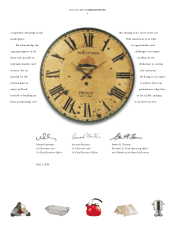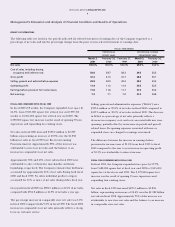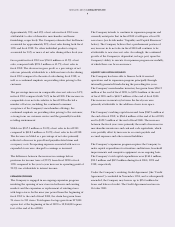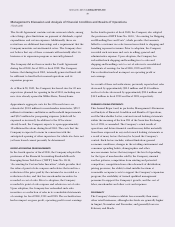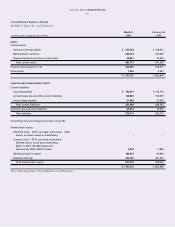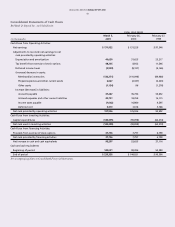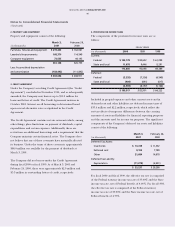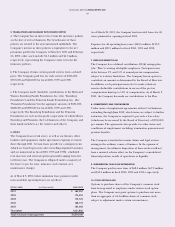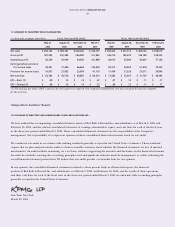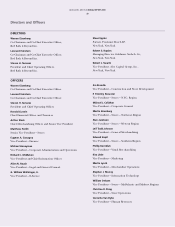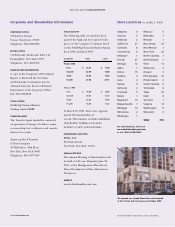Bed, Bath and Beyond 2000 Annual Report Download - page 16
Download and view the complete annual report
Please find page 16 of the 2000 Bed, Bath and Beyond annual report below. You can navigate through the pages in the report by either clicking on the pages listed below, or by using the keyword search tool below to find specific information within the annual report.
BED BATH & BEYOND ANNUAL REPORT 2000
14
1. SUMMARY OF SIGNIFICANT ACCOUNTING POLICIES
AND RELATED MATTERS
A. NATURE OF OPERATIONS
Bed Bath & Beyond Inc. (the “Company”) is a nationwide chain
of “superstores” selling predominantly better quality domestics
merchandise and home furnishings. As the Company operates
in the retail industry, its results of operations are affected by
general economic conditions and consumer spending habits.
B. PRINCIPLES OF CONSOLIDATION
The accompanying consolidated financial statements include the
accounts of the Company and its subsidiaries, all of which are
wholly owned.
All significant intercompany balances and transactions have
been eliminated in consolidation.
C. FISCAL YEAR
The Company’s fiscal year is comprised of the 52 or 53 week
period ending on the Saturday nearest February 28. Accordingly,
fiscal 2000 represented 53 weeks and ended on March 3, 2001;
fiscal 1999 and fiscal 1998 represented 52 weeks and ended on
February 26, 2000 and February 27, 1999, respectively.
D. RECENT ACCOUNTING PRONOUNCEMENTS
In the fourth quarter of fiscal 2000, the Company adopted the
provisions of the Financial Accounting Standards Board’s
Emerging Issues Task Force (“EITF”) Issue No. 00-14,
“Accounting for Certain Sales Incentives”, which provides that
the value of point of sale coupons and rebates that result in a
reduction of the price paid by the customer be recorded as a
reduction of sales, and that free merchandise incentives be
recorded as cost of sales. Prior to adoption, the Company
recorded its point of sale coupons and rebates in cost of sales.
Upon adoption, the Company has reclassified such sales
incentives as a reduction of sales in its consolidated statements
of earnings for fiscal 2000, 1999 and 1998. The reclassification
had no impact on gross profit, operating profit or net earnings.
In the fourth quarter of fiscal 2000, the Company also adopted
the provisions of EITF Issue No. 00-10, “Accounting for Shipping
and Handling Fees and Costs”, which provides that amounts
billed to a customer in a sale transaction related to shipping and
handling represent revenues. Prior to adoption, the Company
recorded such revenues and costs in selling, general and
administrative expense. Upon adoption, the Company has
reclassified such shipping and handling fees to sales and
shipping and handling costs to cost of sales in its consolidated
statements of earnings for fiscal 2000, 1999 and 1998.
The reclassification had no impact on operating profit or
net earnings.
As a result of these reclassifications, previously reported net sales
decreased by approximately $20.5 million and $14.9 million
and cost of sales decreased by approximately $20.4 million and
$14.9 million in fiscal 1999 and fiscal 1998, respectively.
E. EARNINGS PER SHARE
The Company presents earnings per share on a basic and
diluted basis. Basic earnings per share has been computed by
dividing net earnings by the weighted average number of shares
outstanding. Diluted earnings per share has been computed by
dividing net earnings by the weighted average number of shares
outstanding including the dilutive effect of stock options.
F. STOCK-BASED COMPENSATION
As permitted under Statement of Financial Accounting
Standards (“SFAS”) No. 123, “Accounting for Stock-Based
Compensation”, the Company has elected not to adopt the fair
value based method of accounting for its stock-based
compensation plans, but continues to apply the provisions of
Accounting Principles Board Opinion No. 25, “Accounting for
Stock Issued to Employees” (“APB No. 25”). The Company has
complied with the disclosure requirements of SFAS No. 123.
G. CASH AND CASH EQUIVALENTS
The Company considers all highly liquid instruments purchased
with maturities of three months or less to be cash equivalents.
H. MERCHANDISE INVENTORIES
Merchandise inventories are stated at the lower of cost or
market, determined by the retail inventory method
of accounting.
Notes to Consolidated Financial Statements


